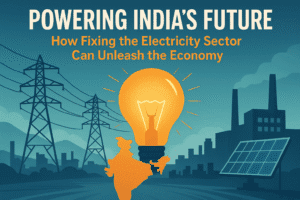Powering India’s Future: How Fixing the Electricity Sector Can Unleash the Economy
India’s power sector, rather than being an engine of growth, acts as a massive drag on the economy by imposing a hidden 100% tax on manufacturing through inflated electricity prices. This cripples competitiveness, especially for small businesses, while a system of cross-subsidies fuels a troubling subsidy regime. The narrative of power subsidies benefiting only farmers is outdated, as households now claim nearly half of all subsidies, which amount to over 1% of GDP.
Worse, the vast majority of these household subsidies flow to the middle-class and affluent, not the poor. This misallocation creates a vicious cycle: wasteful spending on the non-poor is funded by a stifling tax on productive enterprise. Reforming this broken system requires radical simplicity, cost-reflective pricing, and an end to the destructive practice of cross-subsidization. Unleashing India’s economic potential hinges critically on modernizing this last bastion of inefficient public monopoly.

Powering India’s Future: How Fixing the Electricity Sector Can Unleash the Economy
While the world watches the rise of China as an electro-state, fuelling its future with abundant, renewable energy for AI, data centres, and electric vehicles, India is grappling with a self-imposed handicap. The very sector that should be the engine of growth—electricity—is instead holding the economy back.
The current economic climate, marked by uncertain growth and global headwinds, demands a response reminiscent of the 1991 reforms. But this time, the most critical battlefield for supply-side reform isn’t in the corridors of the finance ministry; it’s in the nation’s tangled and inefficient power distribution system.
The problems of loss-making discoms and state bailouts are well-known. But to see this only as a sectoral issue is to miss the larger, more alarming picture. The power crisis is a silent, massive tax on India’s competitiveness and a drain on its development potential.
The Three Hard Truths About India’s Power Problem
Recent research reveals three stark facts that quantify the damage being done.
- The 100% “Stealth Tax” on Manufacturing Imagine a government imposing a 100% tax on the production of goods. Economists would unanimously condemn it as destructive. Yet, this is effectively what Indian manufacturing endures through its electricity bills.
On average, firms pay twice the efficient cost of supply. Half of this is due to the gross inefficiencies of the distribution sector—theft, losses, and poor management. The other half is a deliberate policy of cross-subsidization, where industrial and commercial users are overcharged to fund subsidies for other sectors.
This “tax” falls hardest on small and medium enterprises (SMEs), the backbone of job creation. Larger players often bypass this by setting up their own costly captive power plants or negotiating special deals. This policy is an own goal, crippling the labour-intensive, export-oriented sectors where India needs to compete globally.
- The Shift: Households Are Now the Biggest Subsidy Sponges The narrative of power subsidies has long been dominated by agriculture. But a quiet revolution has occurred. While agricultural subsidies remain massive, households have rapidly caught up.
Subsidies to agriculture and domestic consumers together amount to a staggering 1.2-1.3% of GDP. In 2015, agriculture consumed 71% of this pie. Today, that share has shrunk to about 53%. Meanwhile, the household share has ballooned from 29% to nearly half. Driven by competitive populism, free or highly subsidized power for homes is now a primary fiscal drain.
- The Dirty Secret: Subsidies for the Rich This is perhaps the most damaging insight. It’s not the poor who benefit most from these subsidies; it’s the middle class and the affluent.
An estimated 70-85% of domestic electricity subsidies flow to non-poor households. In some states, even the wealthiest homes don’t pay the full cost of their power. This is a policy failure of epic proportions. Unlike food or fuel subsidies, electricity is metered—the beneficiaries are known and identifiable. There is no excuse for this lack of targeting.
The result is a vicious cycle: generous, misguided subsidies for the well-off are financed by a stifling tax on productive enterprises. This creates a double whammy of inefficiency, stifling growth and punishing job creation.
Charting a Path to Reform: Principles for a Powerful India
Unravelling this decades-old equilibrium won’t be easy. State governments and regulators are entrenched in this damaging status quo. However, a new approach is possible, built on a few core principles:
- Radical Simplicity: Electricity tariffs should vary only for technical reasons (like voltage levels), not as a tool for social policy.
- Efficiency First: No user should pay for the system’s inefficiencies. Discoms must be made accountable for their losses.
- Cost-Reflective Pricing: All users, except the genuinely poor who should be directly supported by the state, must pay the efficient cost of supply.
- End the Cross-Subsidy Folly: The practice of overcharging businesses to fund subsidies must be consigned to history. It is a hidden tax that destroys competitiveness.
The central government can play a key role by designing reform packages that focus not just on overall discom profitability but specifically on mandating rational tariffs and separating out subsidy costs. Facilitating orderly exit for terminally ill discoms could also create necessary pressure for change.
The transformation of India’s telecommunications sector from a public sector monopoly into a competitive powerhouse sparked an economic revolution. A similar upheaval is desperately overdue in electricity. Recognizing the problem is the first step, and recent high-level announcements suggest the message is being heard. For India to claim its economic destiny, it must first plug into a new future—one powered by efficient, affordable, and rational electricity for all. The current system isn’t just broken; it’s actively holding the nation back.
You must be logged in to post a comment.